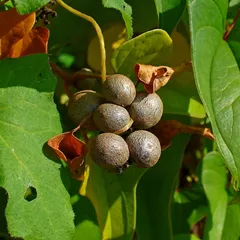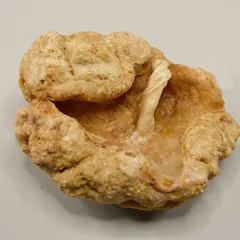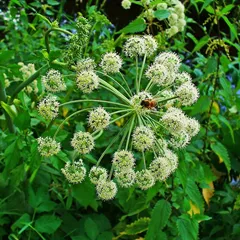Liver Blood and Kidney Essence Deficiency
The information provided here is not a replacement for a doctor. You shouldn't use it for the purpose of self-diagnosing or self-medicating but rather so you can have a more informed discussion with a professional TCM practitioner.
Pathology
Liver Blood and Kidney Essence Deficiency is a pattern of disharmony in Chinese Medicine.
Chinese Medicine views the human body as a complex system that tends toward harmony. A pattern of disharmony is a disorder that prevents that harmony from occurring.
Patterns give rise to symptoms that may at first glance seem unrelated from a Western standpoint but that actually make a lot of sense when one understands Chinese Medicine theory. For instance here Liver Blood and Kidney Essence Deficiency gives rise to such diverse symptoms as no menstruation by 18, lower back pain, fatigue and knee pain (as well as ten others).
To diagnose a pattern, analyzing a patient's pulse as well as their tongue is common practice. In the case of Liver Blood and Kidney Essence Deficiency patients tend to exhibit deep (Chen) or weak (Ruo) pulses as well as a pale tongue.
Patterns aren't exactly the Chinese Medicine equivalent to Western diseases, they're rather the underlying causes behind diseases or health conditions. Here Liver Blood and Kidney Essence Deficiency is thought to sometimes induce conditions such as absence of menstruation.
Diagnosing Liver Blood and Kidney Essence Deficiency
Diagnosing a pattern in Chinese Medicine is no easy feat and should be left to professional practitioners. In particular one has to know how to differentiate between different types of pulses and tongue coatings, shapes and colors as well as learn to read from a long list of seemingly unrelated symptoms.
Pulse type(s): Deep (Chen) or weak (Ruo)
Tongue color: Pale
Main symptoms: Fatigue Dry skin Knee pain Dizziness Dark face Dry mouth Depression Amenorrhea Low energy Dry throat Night sweats Lower back pain Feeling of cold No menstruation by 18
Treating Liver Blood and Kidney Essence Deficiency
Herbal formulas used to treat Liver Blood and Kidney Essence Deficiency



The top herbs in Liu Wei Di Huang Wan are Prepared Rehmannia (Shu Di huang), Cornelian Cherries (Shan Zhu Yu) and Yam (Shan Yao)
Liu Wei Di Huang Wan
Source date: 1119 AD
Number of ingredients: 6 herbs
Key actions: Enriches the yin and nourishes the Kidneys.
Formula summary
Liu Wei Di Huang Wan is a 6-ingredient Chinese Medicine formula. Invented in 1119 AD, it belongs to the category of formulas that nourish Yin and tonify.
Besides Liver Blood and Kidney Essence Deficiency, Liu Wei Di Huang Wan is also used to treat Blood Deficiency or Yin Deficiency.



The top herbs in He Che Da Zao Wan are Human Placentas (Zi He Che), Tortoise Plastrons (Gui Ban) and Poria-Cocos Mushrooms (Fu Ling)
He Che Da Zao Wan
Number of ingredients: 11 herbs
Key actions: Tonifies the Kidneys. Strengthens the Directing and Penetrating Vessels. Regulates the periods.
Formula summary
He Che Da Zao Wan is a 11-ingredient Chinese Medicine formula. It belongs to the category of formulas that tonify Yin and Yang.
Besides Liver Blood and Kidney Essence Deficiency, He Che Da Zao Wan is also used to treat Kidney and Liver Yin Deficiency or Spleen or Kidney Qi Deficiency.



The top herbs in Dang Gui Di Huang Yin are Dong Quai (Dang Gui), Prepared Rehmannia (Shu Di huang) and Cornelian Cherries (Shan Zhu Yu)
Dang Gui Di Huang Yin
Source date: 1640 AD
Number of ingredients: 7 herbs
Key actions: Nourishes Blood. Tonifies Kidney and Liver Yin. Regulates the menstrual cycle.
Formula summary
Dang Gui Di Huang Yin is a 7-ingredient Chinese Medicine formula. Invented in 1640 AD, it belongs to the category of formulas that tonify Blood.
Besides Liver Blood and Kidney Essence Deficiency, Dang Gui Di Huang Yin is also used to treat Kidney Yin Deficiency or Kidney-Deficiency.
Special highlight: the link between absence of menstruation and Liver Blood and Kidney Essence Deficiency

Dong Quai (Dang Gui) is the key herb for Dang Gui Di Huang Yin, a formula used for absence of menstruation caused by Liver Blood and Kidney Essence Deficiency
Typical symptoms for absence of menstruation caused by Liver Blood and Kidney Essence Deficiency: Fatigue Dry skin Knee pain Dizziness Dark face Dry mouth Depression Amenorrhea Low energy Dry throat Night sweats Lower back pain Feeling of cold No menstruation by 18
Recommended herbal formulas: Dang Gui Di Huang Yin, Liu Wei Di Huang Wan, He Che Da Zao Wan
According to TCM Kidney Essence is the origin of menstrual Blood. Also TCM believes that the Liver stores Blood. The malfunction of these two Organs together causes the emptiness of the Penetrating and Directing Vessels, in charge of directing Blood to the Uterus. Kidney Essence Deficiency can also cause Kidney Yang Deficiency which leads to the pattern of Cold in the Uterus and amenorrhoea as a symptom.
This pattern is seen more often among young women, especially for the primary amenorrhoea...Read more about absence of menstruation
